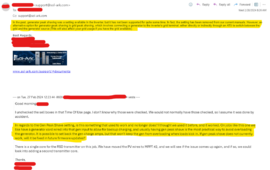Just a heads up to anyone who may have questions and/or issues with the gen input and gen shave function!
According to Sol-Ark tech support, the gen shave function is no longer supported. I am quite confused as to why they would drop that! (Especially since it is still in the menu!) It is a very important part of using the gen terminals for gen charging!
The idea is that you set gen shave to whatever wattage that your generator can comfortably handle, then the inverter adjusts the charge rate in realtime as your passthrough loads go up or down, to maximize gen usage during gen run times, while avoiding overloading and/or low voltage or frequency because of the generator being close to overload.
I'm sure someone will say "adjust the 'gen start A' setting". But that does not compensate for fluctuating loads, and frankly, doesn't work well! I have seen this time and time again with many other brands of inverter! For instance, I have seen many Magnum inverters that had "shore" or "input amps" (depending on advanced remote or not) set to the full 30A with that max charge rate set to lower than 100% to compensate for a small generator. But the instant you have bigger loads kick in, the generator will either overload, or the voltage will drop and the inverter will disconnect. Then it will reconnect.... disconnect.... reconnect..... you get the point.
A breaker size setting or input amps (or watts) setting is always far superior. And really without that it is a disaster!
Note* in an off-grid scenario, you can still use the grid terminals and set grid peak shave to limit that generator draw! The issue is when you either have grid and want a backup gen charge option, or when off grid with a hardwired gen on grid input, and you want a portable charge option on gen terminals.
Note #2* Don't bother mentioning that you can use a standalone charger. I am aware of this. In fact the Eg4 Chargeverter is my go-to option for that. However, the fact that the Sol-Ark inverters physically have the capability to use a generator on the gen input terminals, but the software is simply not programmed to handle it correctly, is what makes no sense to me.
Also, the point of this thread is to make others aware, and perhaps shed some light on any issues that others may have with the gen input and the gen shave menu item.
Here is a screenshot of my conversation with Sol-Ark tech support where I was made aware of this:
According to Sol-Ark tech support, the gen shave function is no longer supported. I am quite confused as to why they would drop that! (Especially since it is still in the menu!) It is a very important part of using the gen terminals for gen charging!
The idea is that you set gen shave to whatever wattage that your generator can comfortably handle, then the inverter adjusts the charge rate in realtime as your passthrough loads go up or down, to maximize gen usage during gen run times, while avoiding overloading and/or low voltage or frequency because of the generator being close to overload.
I'm sure someone will say "adjust the 'gen start A' setting". But that does not compensate for fluctuating loads, and frankly, doesn't work well! I have seen this time and time again with many other brands of inverter! For instance, I have seen many Magnum inverters that had "shore" or "input amps" (depending on advanced remote or not) set to the full 30A with that max charge rate set to lower than 100% to compensate for a small generator. But the instant you have bigger loads kick in, the generator will either overload, or the voltage will drop and the inverter will disconnect. Then it will reconnect.... disconnect.... reconnect..... you get the point.
A breaker size setting or input amps (or watts) setting is always far superior. And really without that it is a disaster!
Note* in an off-grid scenario, you can still use the grid terminals and set grid peak shave to limit that generator draw! The issue is when you either have grid and want a backup gen charge option, or when off grid with a hardwired gen on grid input, and you want a portable charge option on gen terminals.
Note #2* Don't bother mentioning that you can use a standalone charger. I am aware of this. In fact the Eg4 Chargeverter is my go-to option for that. However, the fact that the Sol-Ark inverters physically have the capability to use a generator on the gen input terminals, but the software is simply not programmed to handle it correctly, is what makes no sense to me.
Also, the point of this thread is to make others aware, and perhaps shed some light on any issues that others may have with the gen input and the gen shave menu item.
Here is a screenshot of my conversation with Sol-Ark tech support where I was made aware of this:



